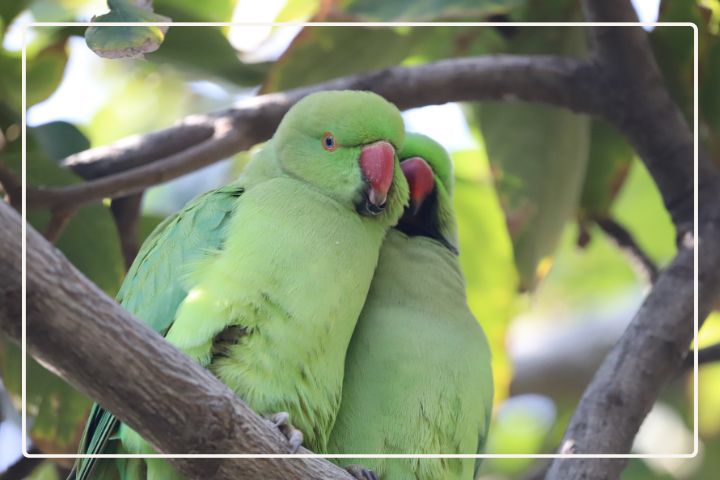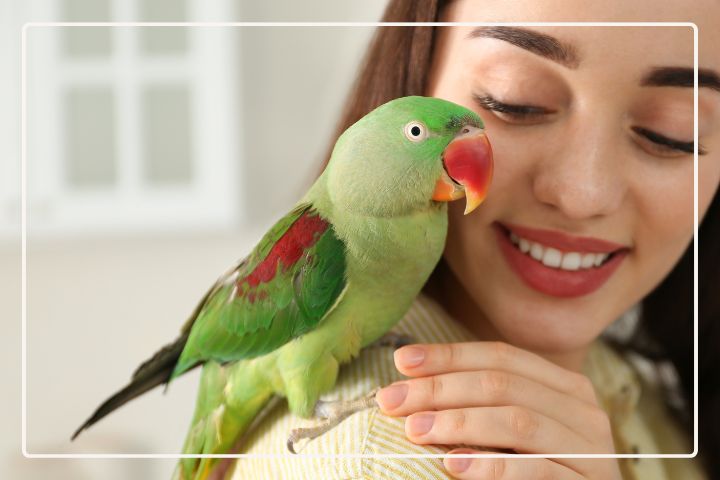Do Indian Ringnecks Get Along With Other Ringnecks?
Indian Ringnecks (IRN) are known to be social and affectionate, but many potential owners may wonder if they can get along with other Ringnecks. While some sources suggest that Indian Ringnecks can be kept together, others warn that they can be territorial and aggressive towards each other.
Understanding Indian Ringnecks is crucial to determining whether they can get along with other Ringnecks. These birds are intelligent and require mental stimulation to remain healthy and happy. They are also known to form strong bonds with their owners, which can sometimes lead to jealousy and territorial behavior. Additionally, Indian Ringnecks can be quite vocal, which can be problematic in a shared living space.
Key Takeaways
- Indian Ringnecks can be social birds but may exhibit territorial and aggressive behavior towards other Ringnecks.
- Understanding Indian Ringnecks’ behavior and providing mental stimulation is key to keeping them healthy and happy.
- Interactions among Indian Ringnecks can be unpredictable, and it is important to monitor their behavior closely to prevent conflicts.
Understanding Indian Ringnecks

Indian Ringnecks are known to be social birds and enjoy the company of other birds. However, like any other parrot species, they have their own personalities and preferences when it comes to socializing with other birds.
When it comes to living with other birds, Indian Ringnecks can be compatible with other Ringneck Parrots as long as they are introduced properly. IRN need plenty of attention and social interaction, so they should not be the only bird in the household.
It is important to note that Indian Ringnecks are intelligent and curious birds that love to explore their surroundings. Their cage should be spacious and have plenty of toys and perches to keep them entertained and stimulated.
Housing Indian Ringnecks
When it comes to housing Indian Ringnecks with other Ringnecks or birds, it is important to consider the size of the cage or aviary. These birds are active and require enough room to fly, play, and perch comfortably. If you plan to house multiple birds, the cage should be ideally 36 inches wide, 36 inches deep, and 48 inches high or larger. The cage should be equipped with multiple perches, toys, and feeding stations to prevent competition and boredom. It is also important to provide enough space to avoid conflicts between birds.
It is generally not recommended to house Indian Ringnecks with other species of birds, as they can be territorial and may not get along. However, if they are introduced slowly and carefully, it is possible for Indian Ringnecks to live peacefully with other birds. Some birds that Indian Ringnecks are compatible with include budgies, cockatiels, lovebirds, and conures.
When housing Indian Ringnecks together, it is important to monitor their behavior closely. If any aggression or territorial behavior is observed, it may be necessary to separate the birds to prevent injury.

Interactions Among Indian Ringnecks
Indian Ringnecks are social creatures and enjoy spending time with other birds. They are known to interact and bond with each other, especially when they are of the same species. When two IRNs are introduced to each other, they may not immediately get along. It takes time for birds to interact and socialize with each other. However, with patience and proper care, Indian Ringnecks can pair up and become lifelong companions, spending most of their time together.
As generally recommended by avian experts, when introducing two birds, it is important to provide them with plenty of space and separate food and water dishes. It is also important to supervise their interactions and separate them if they become aggressive towards each other.
Behavioral Traits of Indian Ringnecks
Indian Ringneck Parrots are known for their noisy and talkative nature. They can be quite loud and vocal, especially during their breeding season. However, this trait can be minimized with proper training and socialization. Ringnecks are intelligent and can learn to mimic human speech and sounds.

When it comes to aggression, it depends on the bird. Some Ringnecks can be aggressive towards other birds, while others bond well with them. Ringnecks can be kept with other birds, but it depends on the bird’s personality and experience. If a Ringneck has had a bad experience with other birds, they may be more aggressive towards them in the future.
If you want to keep IRNs with other birds, it’s better to introduce them slowly and carefully. Birds of similar size, such as budgies, cockatiels, lovebirds, and conures, have a better chance of getting along with Ringnecks. However, it’s always recommended to supervise their interactions, especially during the initial stages.
Ringnecks bond well with their owners and can be quite affectionate. They need space to fly and play, so a large cage or aviary is recommended. They also need mental stimulation, so provide them with toys and puzzles to keep them entertained.
Adopting Indian Ringnecks
Adopting Indian Ringnecks can be a rewarding experience for bird enthusiasts. However, before adopting, it is important to consider their social behavior and compatibility with other birds. Having two Indian Ringnecks of opposite gender is a good option for those who want to keep them as pets. However, it is important to note that not all Indian Ringnecks get along with each other.
When adopting a pair of Ringnecks, it is important to introduce them slowly and carefully. Birds that have not been raised together may not immediately get along and may show aggression towards each other. It is recommended to keep them in separate cages initially and allow them to get used to each other’s presence before introducing them and ensure that they do not show signs of aggression.
Male Indian Ringnecks tend to be more aggressive towards other males and may not get along with each other. On the other hand, female Indian Ringnecks are known to be more social and can form strong bonds with other females.
Ensuring Indian Ringnecks’ Health
Ringnecks can carry and spread bacterial infections to one another, so it is important to keep their living space clean and disinfected. Feather plucking is another physical concern that can arise when Ringnecks are housed together. Feather plucking can be caused by stress or boredom, so it is important to provide plenty of toys and activities to keep the birds entertained.

In addition to physical health concerns, it is important to be aware of the psychological health of Ringnecks when housing them together. Ringnecks need interaction with other birds or humans. If they are left alone for too long, they can become depressed and develop behavioral problems.
Another psychological concern is beak damage. Ringnecks can be aggressive towards one another and may bite each other’s beaks, causing damage. It is important to monitor the birds closely and separate them if any aggressive behavior is observed.
Finally, keeping their living space clean and disinfected, providing plenty of toys and activities, and monitoring their behavior can all help ensure the birds’ health and well-being.
Providing Entertainment for Indian Ringnecks
Indian Ringnecks are social creatures that enjoy the company of their owners and also enjoy having a roommate. However, it is important to provide them with plenty of toys and entertainment to keep them engaged and stimulated.
There are various types of toys available in the market that are suitable for Indian Ringnecks. These toys include wooden blocks, bells, ropes, and swings. It is essential to provide them with a variety of toys to keep them entertained and prevent boredom.
Indian Ringnecks are also intelligent birds that enjoy learning new things. Owners can provide them with interactive toys that require them to solve puzzles or perform certain actions to get a reward. This type of toy not only entertains them but also helps to keep their minds sharp.

In addition to toys, Indian Ringnecks also enjoy having access to natural materials such as branches and leaves. These materials provide them with a sense of the outdoors and can help to keep them mentally and physically healthy.
It is important to rotate toys regularly to prevent boredom and keep them interested. Owners should also ensure that the toys are safe and do not contain any small parts that can be swallowed.
Frequently Asked Questions
What are the best ways to introduce two Indian Ringnecks?
When introducing two Indian Ringnecks, it is important to do so gradually and in a neutral space. The birds should be able to see and hear each other, but not touch. This allows them to get used to each other’s presence without feeling threatened. Once they seem comfortable, you can gradually move them closer together until they are comfortable sharing a space.
Do Indian Ringnecks form strong bonds with their companions?
Yes, Indian Ringnecks are known for forming strong bonds with their companions. They are very social birds and enjoy spending time with their owners. If given enough attention and affection, they can become very attached to their human companions.
What are the potential risks of keeping multiple Indian Ringnecks together?
The biggest risk of keeping multiple Indian Ringnecks together is aggression. If the birds do not get along, they may fight and injure each other. Additionally, keeping multiple birds in the same cage can increase the risk of disease transmission. It is important to keep a close eye on the birds and separate them if necessary.
Are Indian Ringnecks better off living in pairs or alone?
Indian Ringnecks are social birds and generally do better with companionship. They can live in pairs or small groups, but it is important to make sure that the birds get along before introducing them. If a bird is kept alone, it may become bored and develop behavioral problems.
Can Indian Ringnecks coexist with other parrots?
Indian Ringnecks can coexist with other parrots, but it is important to introduce them carefully and monitor their interactions. Some parrots may be more aggressive than others, and it is important to make sure that the birds are compatible before leaving them alone together.
How can you tell if your Indian Ringneck is compatible with another parrot?
The best way to tell if your IRN will get along with other birds and are compatible is to introduce them gradually and observe their behavior. If the birds seem comfortable around each other and do not show signs of aggression, they may be compatible. However, if they show signs of aggression or do not seem to get along, it may be best to keep them separated.
What should be done if your Indian Ringnecks don’t get along?
If your Indian Ringnecks don’t get along, it is important to separate them immediately. Fighting can lead to serious injuries or even death. Once the birds are separated, you can try reintroducing them gradually and in a neutral space. If they still do not get along, it may be best to keep them separated permanently.
Read our article on the Overview, Characteristics and Care of Indian Ringneck Parakeets
Conclusion
Indian Ringneck Parakeets can get along with other Ringnecks, but it depends on various factors such as their gender, age, and personality. It is recommended to introduce the birds slowly and monitor their behavior closely to prevent any aggression or fighting.
Ringnecks can share the same cage, but they should have their own space and toys to prevent territorial behavior. It is also suggested to get a Ringneck of the opposite gender to prevent same-sex aggression.
Young Ringnecks can form bonds with other species and live with them in harmony. However, it is important to ensure that the other species are compatible with Ringnecks and have similar temperaments. It is crucial to socialize them early and provide them with plenty of attention and training.
Pros and Cons of having multiple Indian Ringneck Parakeets:
| Pros | Cons |
|---|---|
| Provide companionship for each other | Increased noise level |
| Can form strong bonds with each other | Increased mess and maintenance |
| May exhibit natural behaviors such as preening and playing together | Risk of aggression and fighting |
| Can be entertaining to watch their interactions | Increased cost for food, toys, and veterinary care |
At the end of the day, it is up to the owner to decide whether having multiple Ringnecks is right for them and their lifestyle. Proper research, preparation, and care can lead to a happy and harmonious environment for the birds.








Thanks for all your efforts that you have put in this. very interesting information.